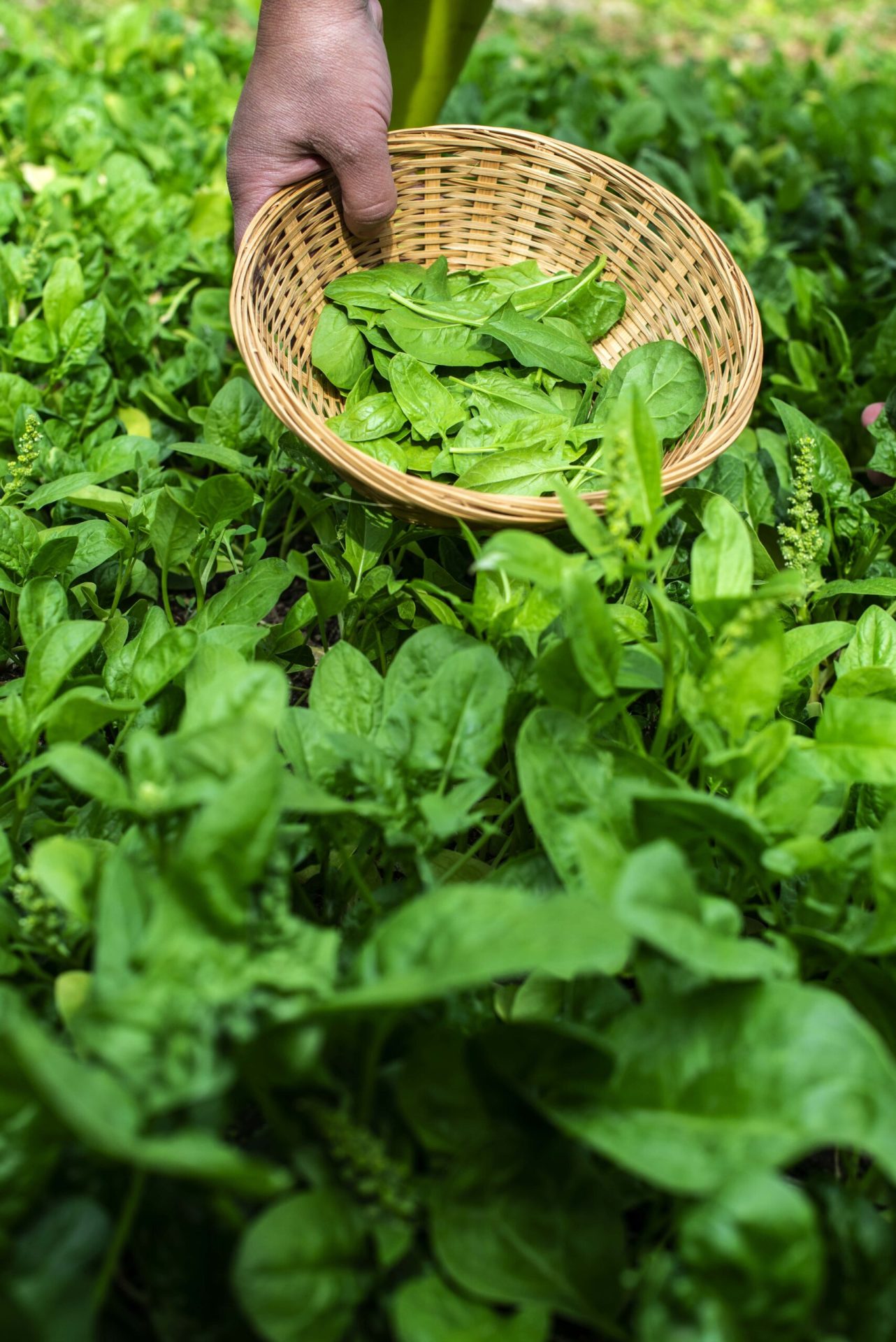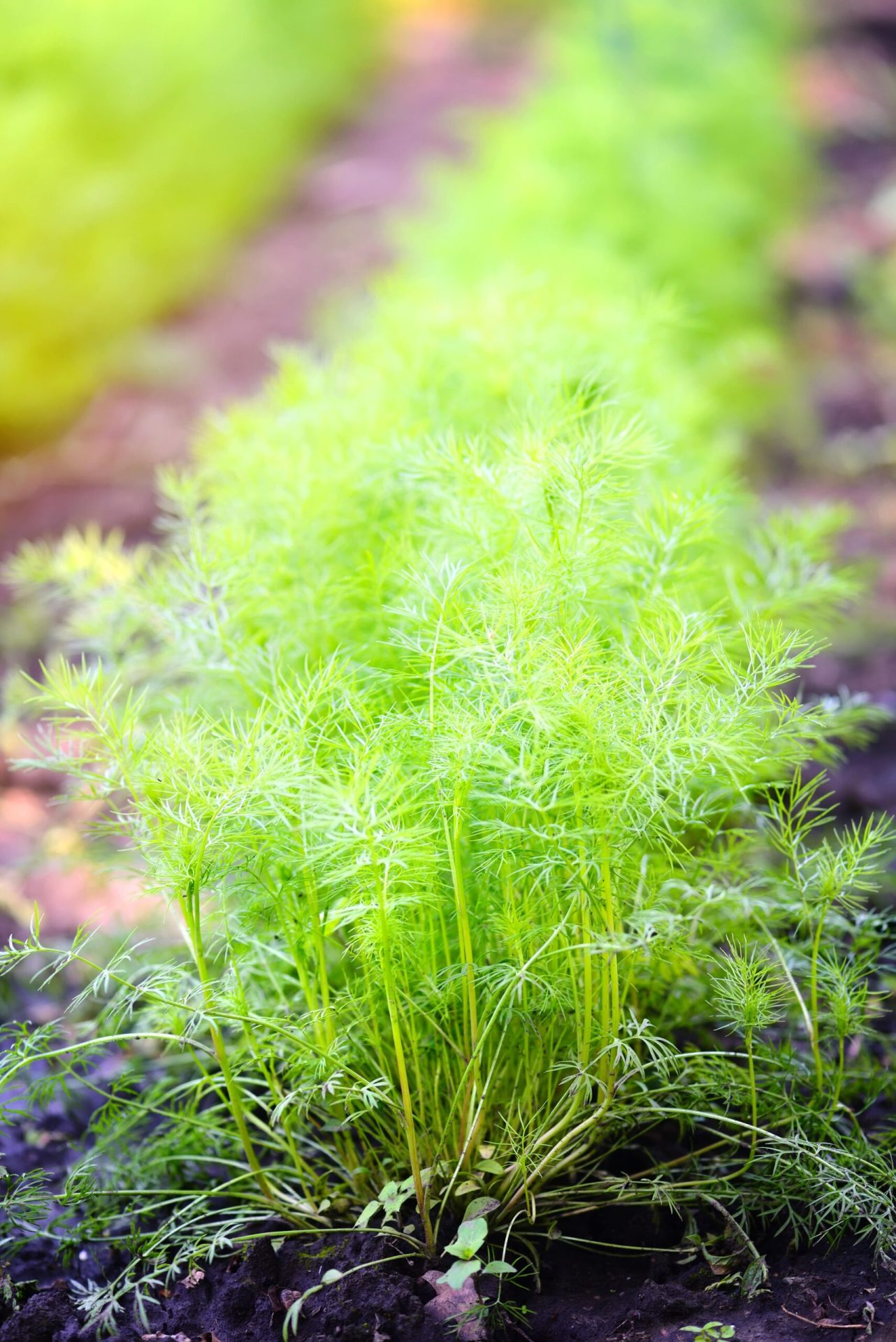Radishes are easy to grow as they can tolerate different soil types and grow quickly. You can enjoy radish in either raw or cooked form. They offer a fiery burst of flavor to salads. As they grow quickly, you can sow them continually throughout summer, spring, and early autumn for continuous harvest.
Radishes adds a zesty crunch to salads and absorbs flavors from marinades when roasted. You can transform its green tops into a fresh and vibrant pesto. In this growing guide, you will learn how to grow radish, its growing stages, varieties, storage, and harvest methods. Read on to learn how to grow this nutrition-packed vegetable in your garden.
Growing Radish 101: Step-by-Step Guide
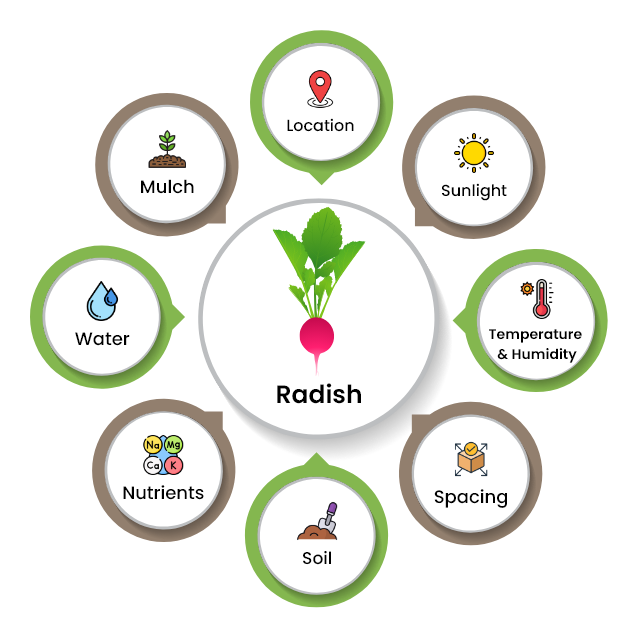
1. Location
Select a proper location which receives at least six hours of direct sunlight daily.
2. Temperature & Humidity
Radish plants thrive well in temperatures between 40-70°F. They do well when stored at a relative humidity of 95-100%.
3. Spacing
Sow radish seeds around ½ inch deep and 1-2 inches apart.
4. Soil
Radish thrives in rich, loamy, or sandy, well-draining soil that is slightly acidic to neutral. It should have a pH of 6.0-7.0.
5. Nutrients
If you grow radishes in rich soil, you will not require fertilizers. However, if you want to improve the soil, work in a few inches of compost before planting.
6. Water
Radish plants require at least 1 inch of water every week.
7. Mulch
Apply a thin layer of mulch like fine straw or untreated sawdust around the soil.
How to Grow Radish from Seeds?
- Choose a well-draining soil that has plenty of organic matter.
- Loosen the soil to at least 6 inches depth and remove debris.
- Sow radish seeds directly into the prepared soil.
- Plant the seeds about ½ inch deep and space them about 1 inch apart in rows.
- The soil should be kept consistently moist.
- Select a location where plants can receive sunlight for at least 6-8 hours daily.
- Water plants deeply once/twice a week based on the soil, weather conditions and moisture levels.
- Once the radish seedlings emerge, thin them out to ensure proper spacing.
- It prevents overcrowding and allows the remaining ones to develop healthy plants.
How to Grow Radish in Containers?
- Choose a container that is at least 4-6 inches deep.
- Ensure it has sufficient drainage holes.
- Before sowing seeds in the container, fill it with potting mix and keep it in the sun for 6-7 hours. This will warm up the potting mix.
- Plant radish seeds about ½ inch deep and space them one inch apart.
- Cover them loosely with some potting mix for best results.
- After planting seeds, water them with a water can.
- Keep the potting mix moist and ensure that it gets enough sunlight.
- Seeds germinate in 4-10 days.
- Thin seedlings when seeds sprout so that you space a plant every two inches from each other.
- Ensure the potting mix is moist.
- If the potting mix is well-drained and the container has a proper drainage system, there will be no rotting issue.
How to Transplant Radish Seedlings?
The ideal time to transplant radish seedlings is during early to mid-spring. This ensures their successful growth in optimal conditions.
- Find a location that receives full sun to grow your transplanted radish seedlings.
- Loosen the top of soil about 8-10 inches with a garden fork and mix in organic matter to improve the soil structure.
- Use a shovel/trowel and dig a hole as deep as the root ball and twice as wide.
- Place the radish seedling gently in the center of the hole, making sure to spread out the roots.
- The plant should sit at the same soil depth as it was initially.
- Fill the hole with soil. Firm the soil around the plant’s roots to ensure good air circulation and remove any air pockets.
- Water the transplanted radish seedlings to let the soil settle down and help establish the roots properly.
- Apply an organic mulch layer like shredded bark or compost around the plant.
- This retains moisture and prevents weed growth.
When to Plant Radish?
- For spring crops, sow radish seeds 4-6 weeks before the last spring frost.
- For a fall crop, sow radish seeds about 4-6 weeks before the first fall frost.
How to Plant Radish?
- Mix in organic matter into the soil before sowing radish seeds.
- Directly sow seeds outdoors about ½ inch deep.
- Cover it loosely with soil.
- Space seeds about 1 inch apart and in rows 12 inches apart.
- Water radish seeds thoroughly about 6 inches deep.
Radish Growing Stages
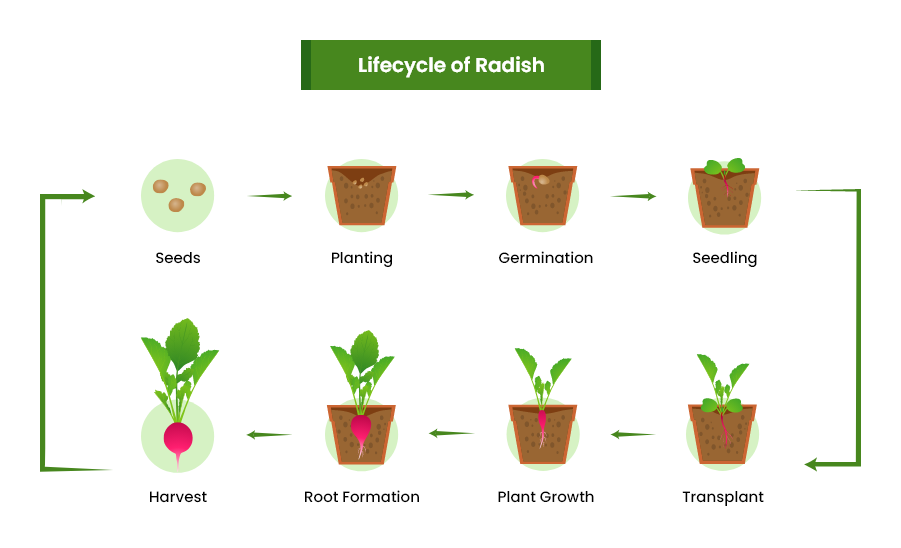
1. Sowing seeds
This stage involves preparing the soil by digging aged compost into it. Plant radish seeds about ½ inches deep and space them about 2 inches apart, or plant them close together. Thin them out later and leave only the strong seedlings.
2. Germination
Radish seeds take about 3-4 days to germinate, but if the soil is still cool, it might take up to 10 days. The first leaves to appear in the seedling are known as cotyledons or seed leaves, which are followed by true green leaves.
3. Seedling
When the seedling emerges, add a low-nitrogen fertilizer to the soil to promote root growth. Since radishes grow quickly, you will have to add fertilizer only once.
4. Root growth
When the plant matures, the root grows larger beneath the soil, and the leaves reach 6-18 inches tall, depending on the variety.
5. Harvesting
Radish plants become ready for harvest in four weeks after planting. Harvest radishes when their roots reach a diameter of 1 – ½ inches on the soil surface.
To harvest, gently pull and twist the radish from the bottom of the greens. Don’t leave radishes in the ground for long; otherwise, they can become woody or bolt to flower.
How to Harvest Radish?
Once radish reaches maturity, you should harvest them as soon as possible. Do not let them stay in the ground for a long time; otherwise, they will turn fibrous and develop a strong and unpleasant taste.
Harvest radish at the right time to enjoy its peak flavor and texture. Both greens and roots are edible and delicious, if you harvest them at the right time. The spiciness may increase if picked at the right time, but you can cook greens and roots to relieve the bite.
- Harvest radish when its leaves grow 4 inches in height.
- To harvest, grab the radish at the base of its green and pull the entire plant straight up from the soil.
- Wiggle it a bit to loosen it gently from the soil and it should emerge easily.
- Separate the root from the greens. If the leaves are attached to the bulb, they will draw moisture and nutrients from it.
- Use a garden fork or trowel to lift the root gently from the soil.
- Cut the tops and tail root from the radish and wash them properly.
- Dry them properly and store them in a plastic bag in the refrigerator.
How to Store Radishes?
You should store radish in the refrigerator. The cool environment helps maintain the consistency and texture of radish.
- Cut the stems off and wash any dirt or invisible residue off each one.
- Wrap radishes in a damp paper towel.
- Put them in a plastic storage bag or leave them as they are.
- Make room for radishes in the crisper drawer section of your fridge.
Best Radish Varieties
Radishes are a common root vegetable available in different colors, shapes, and sizes. There are different varieties of radishes, each one having different nutrients, appearance, flavors, and culinary uses. Let us learn about three radish varieties that you can grow in your home garden.
1. Crimson Giant
Crimson giant grows up to 2 inches in diameter. They are plump and have a mild flavor, which makes them perfect for sandwiches or salad stars. They love cool weather in spring and fall, and it takes about 28 days to mature.
It has 2½ or 3½ inch leafy tops; you can enjoy greens either in raw or cooked form. They are suitable for roasting or quick pickles, as they lose their appealing pink shade when cooked. Owing to their small size, they do not compete for nutrients.
2. Dragon’s Tail
Dragon’s Tail is an Asian heirloom variety that lets you eat its seed pods, not its roots. The plants reach three to four feet tall. This aerial radish variety is leafy, lacy, and blooms in a profusion of pink and white blossoms.
It has edible purple pods, which are harvested when they are about 3-6 six inches long and pencil-thin in size. You can pluck them and use them immediately in a salad or stir-fry them.
They are crisp like Kale or Bok choy with a spicy kick. Its pods take a bit longer to mature than an average spring radish variety—about 50 days from sowing.
3. Fire ‘N’ Ice
This radish variety boasts of an extra-crisp texture and a mild sweet flavor. It is half red and half white, slender, and grows up to 4 inches long. Slice it and use it in your salad or eat it fresh in a sandwich.
If you do not have early frosts, plant this variety in early spring, late summer, or fall. This radish variety cannot tolerate frost, so it is essential to watch the weather. It is ready to eat in about 25 days.
To extend the shelf life of this radish variety, remove its leaves, wrap the roots in plastic, and refrigerate. Storing in this way will prolong its freshness and mild flavor. It will stay fresh for up to five days in the refrigerator.
Common Pests & Diseases Problems with Radish
Pests like aphids, cutworms, flea beetles, harlequin bugs, cabbage maggots, slugs, snails, and cabbage loopers can cause damage to radish plants. Diseases like clubroot, Alternaria blight, downy mildew, white rust, wirestem, black root, scab, and fusarium wilt can damage radish plants.
Companion Plants for Radish
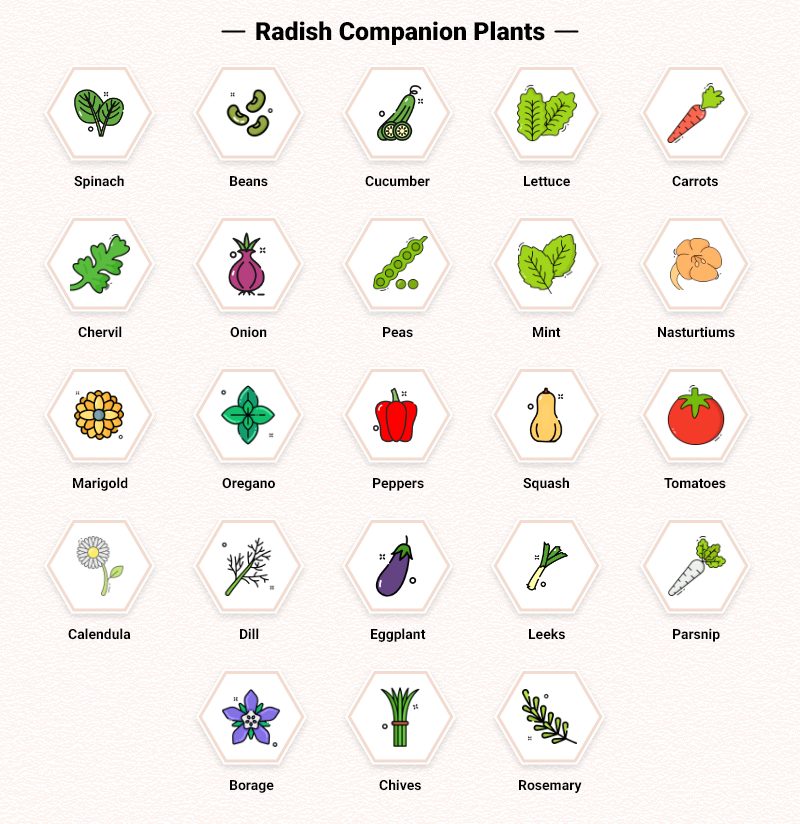
If you plan to grow radishes in your garden, include companion plants. These plants help in pollination, pest control, improve overall soil health, maximize the use of space, suppress weeds, and increase crop productivity. They help gain a mutual advantage in flavor, production, or protection from pests.
Plant radish with spinach, beans, cucumber, lettuce, carrots, onion, peas, mint, nasturtiums, marigold, oregano, peppers, squash, tomatoes, dill, eggplant, leeks, parsnip, borage, chives, and rosemary.


